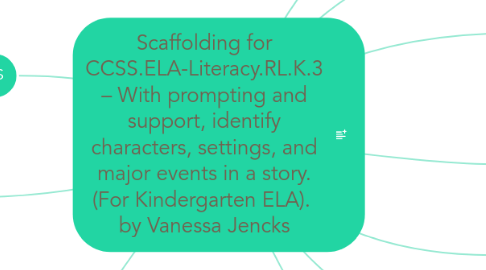
1. BIG IDEAS
1.1. There are main elements in every story.
1.2. These elements help us understand stories.
1.3. Characters, settings and major events are all types of elements.
1.4. A setting includes details of time, length of time and place. The place can be as simple as “my bed” or as complex and big as the whole universe! It depends on each story.
1.4.1. (Big sub-idea) When we ask the question, “WHERE is the story taking place?” we must answer with a setting.
1.5. A story is made up of many events, but the most important things that happen in a story are called major events.
1.5.1. (Big sub-idea) When we ask the questions, "WHAT HAPPENED?" or "HOW did it HAPPEN?" we must answer with a major event.
1.6. A character can be a person, animal or thing that moves or speaks in the story.
1.6.1. (Big sub-idea) When we ask the question, “WHO is the story about?” we must answer with a character.
2. Note: This is a bit of a scaffolding unit in the first place. I picked “Ginger” by Charlotte Voake because of how easy it is to comprehend and distinguish settings, characters and major events. The skills built in this unit should be reused every single time a Kindergarten class reads a new story.
3. Student Factors
3.1. Student age is the biggest factor, and this lead to heavy reliance on preloading vocabulary and building on any prior knowledge. I used the strategies most so I know where students are before trying to get into the meat of the concepts. The simplicity of the story but yet the unfamiliarity of the story (it's not a popular bedtime story), allows students to think about the story without any previous experience. I can then use popular bedtime stories to test their understanding of the concepts later in the unit.
3.2. ELL, male and focus-challenged students - all of these students in general benefit from visual representations of ideas. So, I also relied on visuals and graphic representation for many of these objectives.
3.3. Language Development
4. Objective: SWBAT identify and highlight the four major events in the story.
4.1. I would build on prior knowledge to create a definition for major events and use visuals to accompany this definition.
4.2. Students would work in pairs to decide what the major events are using the timeline built in the previous ELA lesson.
5. Objective: With prompting through coloring pages, SWBAT correctly recall the order of events of Ginger by Charlotte Voake.
5.1. The two scaffolding strategies used here are visuals and a graphic organizer (timeline). If students had trouble remembering as a group, we would start to go back through the book to remember what happened.
6. Objective: SWBAT identify the garden and the little girl's home as settings, NOT the basket, the chair and the cardboard box.
6.1. I would build on prior knowledge to create a definition for settings and use visuals to accompany this definition.
6.2. Another scaffolding technique is to ask them to make a guess about what the two settings of the story are. I would then again, go back through the book to test their hunches with them.
7. Objective: SWBAT distinguish that the basket, the bowl, the flowers, the chair, the table, and the cardboard box are all NOT characters.
7.1. Scaffolding Strategies
7.1.1. This is the second objective of the unit, but also in the first lesson. Scaffolding is provided for students in a group activity where they seperate pictures (bottle puppets) from the story into categories of characters and non-characters.
7.1.2. I would model the group activity and the game for students in order for all students to understand what I want them to do.
8. Objective: SWBAT identify Ginger, the kitten and the little girl as characters.
8.1. Scaffoding Strategies
8.1.1. This is the first objective of the unit. I would provide pre-loaded vocabulary by having students form a definition of a character with me, and also provide visuals to accompany this definition.
8.1.2. While reading the book aloud, I would point to the pictures. Also after reading aloud, I would check for comprehension. If there is a lack of comprehension, I would go back and reread the pertinent parts of the story and re-ask the question for comprehension.
8.1.3. During the second discussion, after having read the book, I would go back to the definition that we created of a character. I would ask, "Who are the characters of the story?" If no one can answer this, I can provide scaffolding through discussion. "WHO is this story about?" "Who else is in the story?" "Does everyone who you have named speak?" This builds up to the big idea definition of a character.
